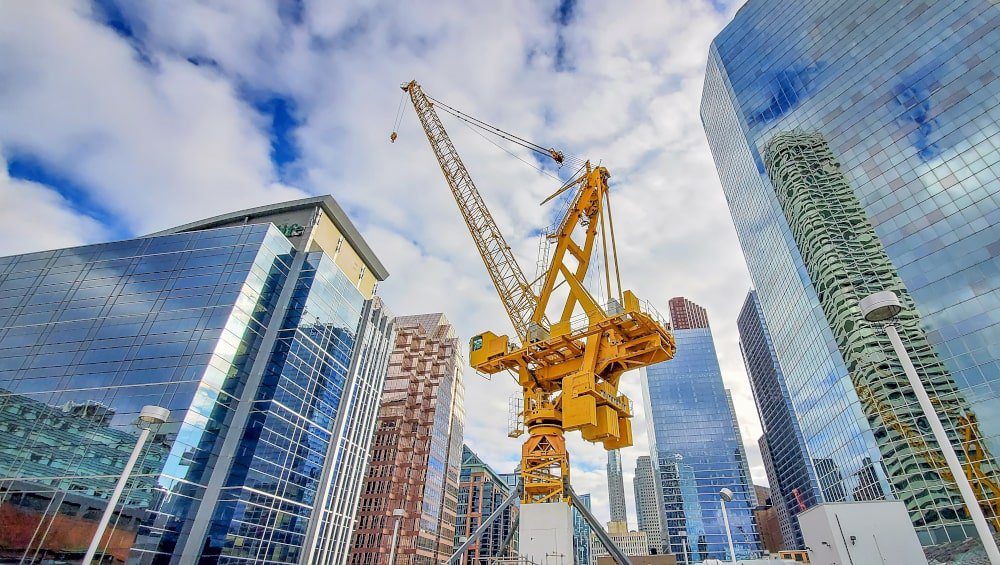The Supply Chain Crisis: Why Demand for Industrial Real Estate is on the Rise

If you have been keeping up with commercial real estate news, specifically industrial real estate news, you may have heard about the shocking surge in demand for industrial properties across the country. This is especially true in major cities across Canada such as Toronto and Vancouver. With industrial vacancy rates at an all-time low and demand for new properties at an all-time high, it is more difficult than ever for companies to expand or establish their operations.
At the root of this issue lies a complex mix of factors, ranging from pandemic-induced labour shortages to a global supply chain backup. If you are currently looking to navigate the industrial real estate market, the first step is to understand the factors that are shaping and shifting the industry.
How the Pandemic Affected Canadian Supply Chains
The Effect of Pandemic-Driven Labour Shortages
The onset of the COVID-19 pandemic in March 2020 saw many workers across the globe transition to remote jobs, fearing for their personal health and safety. As an unfortunate side effect, many workers whose jobs could not be delivered remotely quit altogether. The Canadian labour participation rate alone fell sharply from 65.3 percent to 60.1 percent following the onset of the pandemic, leaving companies scrambling to fill the gaps in their workforces.
One trend we saw across most global markets was the migration of workers from typical industrial areas into more isolated regions. For instance, in South-East Asia, workers left crowded city centers in droves, looking to seek refuge in rural areas for the duration of the pandemic. Unfortunately, these disruptions triggered a global chain reaction that led to unprecedented labour shortages across the international markets.
The international labour shortage stunted progress at every stage of the global supply chain; production and processing wait times hit an all-time high with delays ranging from processing raw materials to the production and shipment of final goods.
The success of the global supply chain is almost entirely dependent on the strength of the available labour force. When there are not enough workers to process raw materials, shipments of raw materials take longer to arrive, which in turn causes delays within manufacturing plants. Delays at one stage of the production process often cause disturbances that span the entire supply chain.
These factors have placed us in a global market where demand far exceeds supply, and no amount of trade can fill that gap.
The Supply Chain Crisis in the Real Estate Market
As the world begins to reopen, households are finding themselves with more spending power than before due to a higher rate of pent-up savings from the pandemic. As demand for labour continues to increase due to global shortages, we are seeing a steady growth in wages across multiple sectors of the Canadian market, giving households more purchasing power. Increased Inflation rates, caused by the discrepancy between supply and demand of goods across all markets, have also caused an increase in average Canadian spending. Coupled with the shift in Canadian spending patterns to prefer the purchase of goods over services, the aforementioned factors make it clear that the current Canadian market is straining its supply chains across all sectors.
In the real estate industry specifically, supply chain hang-ups mean we now find ourselves in a severe building materials shortage. As a result, the prices of common construction materials such as lumber, steel, and pre-cast concrete have reached new highs. Shipping delays further extrapolate this shortage and incite further complications as countries across the globe continue tightening their borders in response to the pandemic. Even if some countries are able to more effectively produce the quantities of building materials demanded by Canadian companies, getting inventory out into international markets is more challenging than ever before. With 90 percent of world trade falling in the hands of shipping and logistics companies, it is easy to see how these disruptions lead to supply shortages within the Canadian real estate sector. The increasing cost of shipping has also played a significant role in the accessibility of building materials; the price of sending one shipping container from China to Canada, for instance, has increased by 700 percent since the onset of the pandemic. The culmination of all these factors has led to a significant increase in construction costs, thereby driving up Canadian rent rates and property prices.
Storage, Logistics, and Manufacturing Space: Why Demand for Industrial Real Estate is On the Rise
Current Drivers of Demand for Industrial Real Estate Development
One of the most profitable side effects of the pandemic is that it has caused a spike in e-commerce sales across all markets and sectors. While health and safety restrictions may threaten the livelihood of brick-and-mortar stores across the country, online shopping sales often mitigate these losses in revenue for most Canadian retail outlets. The rise in the frequency of e-commerce transactions, following the onset of the pandemic, has not only failed to slow down even during periods of reopening but has driven overall purchases to an all-time high. In fact, Canada’s e-commerce sales are at an all-time high, surpassing those of any other nation.
However, an unfortunate side-effect of e-commerce transactions is that they place even more pressure on global supply and distribution channels. A greater amount of warehouse space is required to handle the logistics of shipping goods directly to consumers, as opposed to traditional supplier-to-retail channels of distribution. As the digital sales presence of a company grows, the amount of real estate that they need in order to operate also grows.
Another side effect of the pandemic is the unpredictable surges in demand for various goods that retailers must swiftly react to. This has caused many companies to store additional stock in their inventories, transitioning from a Just-In-Time (JIT) inventory style to the Just-In-Case (JIC) style. Keeping larger inventories requires larger amounts of space, leaving many companies desperate to expand their current collection of industrial facilities. Both these factors have led to skyrocketing demand for warehouses and other types of industrial real estate across Canada.
How are Developers Meeting This Increased Demand?
While demand for industrial real estate continues to rise, industrial vacancy rates are at an all-time low. Canada's current industrial vacancy rate is just 2.4 percent, having remained almost unchanged since 2020, despite considerable surges in demand for industrial real estate in the past year and a half. The US is also facing a severe supply-demand discrepancy when it comes to their industrial real estate markets; Los Angeles, New Jersey, and other major American port cities currently have industrial vacancy rates of just under 2 percent.
In order to adapt to the lack of available construction space, avoid wastage, and maximize the profitability of projects, many developers have begun to operate exclusively on a build-to-suit basis. This means that instead of building generic properties and then attempting to sell them, developers are taking specific orders from clients and constructing buildings that suit their specific needs, tailored on a case-by-case basis. This style of operation has been increasing in popularity since the pandemic, almost doubling in frequency of use since March 2020.
Another strategy some developers are employing is to try and repurpose old warehouses (and other types of industrial buildings) for resale. One way to achieve this is through retrofitting. In this process, older properties have their foundations and load-bearing walls reinforced without damaging or changing the original look of the building; this is a great way to extend the life of the building without compromising its original function.
Refurbishing is also an excellent way to increase the value of an older property; in this case, older elements of the buildings are swapped out and replaced with more modern touches. The greatest challenge for developers is the rapidly changing technological needs of the production process; modern industrial real estate must be able to accommodate the specialized needs of large-scale manufacturers and distributors. Older properties are notoriously difficult to upgrade to suit current technological needs, further exacerbating the current industrial real estate shortage.
The Future of Canada’s Industrial Real Estate Market Post-Pandemic
Considering the current supply chain issues the Canadian real estate market is facing, it can be challenging to adopt a positive outlook on the future of the industry. However, it is important to understand that despite all the global supply and demand challenges faced by the market this year, the Canadian real estate industry is still growing and thriving.
As the pandemic begins to subside, we will likely see a large majority of the current industrial supply chain issues resolve themselves. Once global infection rates start to decline, we can expect that borders will loosen, ports will reopen, and shipping will become less expensive and more efficient as a result. Once global populations feel safe returning to work, we will likely see the labour shortage begin to resolve itself as well, with labour participation rates returning to normal.
As the Occupier of an Industrial Property, What Can You Do?
If you are currently in the market for industrial property, you may have already become discouraged by the difficulty of acquiring the real estate you need. Although the market is in a bit of a tight spot at the moment, here are a few tips you can employ to increase your odds of success:
- Search for properties well before you need them. By planning a few years in advance and establishing good sites for your future expansions, you can avoid the last-minute scramble of finding adequate real estate at the last minute.
- Renew your lease early. Forgetting to renew your lease in a market where industrial buildings sell like hotcakes is undoubtedly a recipe for disaster. You may be left needing to apply for an emergency mortgage .
- Consolidate locations. If you are unable to find the properties you need to expand your production and distribution operations, try consolidating two or more of your existing operations into one building, optimizing the space you have available to you.
- Optimize your operations. Analyzing your own supply chain makes it easy to identify which areas are having the greatest difficulty performing, helping you to determine which areas require the most resource allocation.
- Prioritize labour over rent. It can be difficult to find the ideal price for your lease under the conditions of our current industrial real estate market. However, many companies overlook the other potential benefits that can come with certain properties. Instead of searching for the warehouse with the cheapest rent, prioritize a location that gives you access to a reliable source of labour instead. Given the global labour shortage, having a complete and dependable workforce will provide you with a substantial competitive advantage.
Of course, the best way to increase your odds of success within the industrial real estate market Is to make sure you are making a well-informed decision. Consulting with a real estate professional is an excellent way to increase the scope of your search for the ideal property and ensure you are finding the best deals and rates.
If you are interested in a commercial mortgage or industrial mortgage for purchasing an industrial property or commercial property, or are interested in refinancing a property you already own, schedule a free consultation with a knowledgeable and experienced commercial mortgage broker at Clover Mortgage today!





